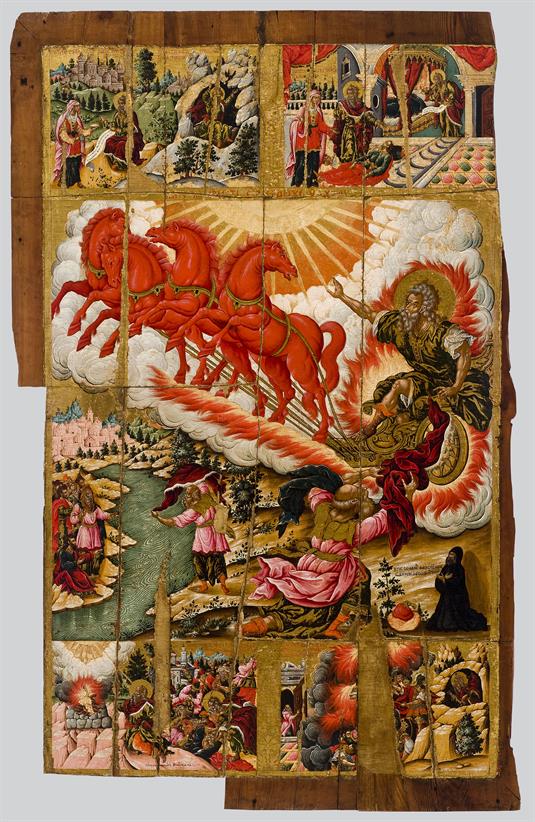The Ascension of the Prophet Elijah and scenes from his life
The icon is divided into three bands. The central one depicts the Ascension of the Prophet Elijah to heaven on a golden chariot of fire. Lower down, Elijah throws his cloak on Elisha to ceremoniously name him as his successor. On the left is the episode according to which Elisha crossed the Jordan in a miraculous manner without getting wet. The main scene copies an engraving by the Flemish print-maker Jan Wierix; the use of Flemish prints to provide iconographic subjects is particularly widespread in the Ionian islands from the second half of the 17th century on.
On the right side, the patron, according to an inscription, the Cretan priest monk Sophronios Faskomelos, is depicted kneeling with his arms crossed. Faskomelos was priest in the Church of Prophetes Ilias (Prophet Elijah) in Ano Korakiana, Kerkyra and, possibly, a refugee of the Cretan War. His family is attested in 1644 in Herakelion and Rethymnon. The icon is signed by Theorodos Poulakis (circa 1620-1692), one of the most important and the most productive painters of the era. Theodore Poulakis was born in Chania, Crete, c. 1620. He lived for some years in Venice and also in Kerkyra (Corfu) and in other Ionian Islands. He often used Flemish engravings as models for his works, as is the case here. The icon, that comes from the Church of Prophetes Ilias (Prophet Elijah) in Ano Korakiana was stolen in 1976. It was cut in nine pieces to be transported easily and sold by looters, who were arrested a few years later. The work, which suffered extensive damage, was located and transported to the Byzantine Museum where it underwent conservation in 1984 and again in 2008-2009.
- Collection: Icons and Wood-Carvings
- Type: PORTABLE ICON
- Origin: Ano Korakiana, Kerkyra (Corfu)
- Creator: Theodoros Poulakis
- Measurement: 188,5 x 123,5 cm
- Exhibit Number: ΒΧΜ 01576
- Appears in: IV.1b. Painting in Ionian Islands: a justifiable hybrid

Comments
Users must be registered and logged in to comment.
No comments found.